The AMD Ryzen 5 2500X and Ryzen 3 2300X CPU Review
by Ian Cutress on February 11, 2019 11:45 AM ESTCPU Performance: Web and Legacy Tests
While more the focus of low-end and small form factor systems, web-based benchmarks are notoriously difficult to standardize. Modern web browsers are frequently updated, with no recourse to disable those updates, and as such there is difficulty in keeping a common platform. The fast paced nature of browser development means that version numbers (and performance) can change from week to week. Despite this, web tests are often a good measure of user experience: a lot of what most office work is today revolves around web applications, particularly email and office apps, but also interfaces and development environments. Our web tests include some of the industry standard tests, as well as a few popular but older tests.
We have also included our legacy benchmarks in this section, representing a stack of older code for popular benchmarks.
All of our benchmark results can also be found in our benchmark engine, Bench.
WebXPRT 3: Modern Real-World Web Tasks, including AI
The company behind the XPRT test suites, Principled Technologies, has recently released the latest web-test, and rather than attach a year to the name have just called it ‘3’. This latest test (as we started the suite) has built upon and developed the ethos of previous tests: user interaction, office compute, graph generation, list sorting, HTML5, image manipulation, and even goes as far as some AI testing.
For our benchmark, we run the standard test which goes through the benchmark list seven times and provides a final result. We run this standard test four times, and take an average.
Users can access the WebXPRT test at http://principledtechnologies.com/benchmarkxprt/webxprt/

WebXPRT 2015: HTML5 and Javascript Web UX Testing
The older version of WebXPRT is the 2015 edition, which focuses on a slightly different set of web technologies and frameworks that are in use today. This is still a relevant test, especially for users interacting with not-the-latest web applications in the market, of which there are a lot. Web framework development is often very quick but with high turnover, meaning that frameworks are quickly developed, built-upon, used, and then developers move on to the next, and adjusting an application to a new framework is a difficult arduous task, especially with rapid development cycles. This leaves a lot of applications as ‘fixed-in-time’, and relevant to user experience for many years.
Similar to WebXPRT3, the main benchmark is a sectional run repeated seven times, with a final score. We repeat the whole thing four times, and average those final scores.
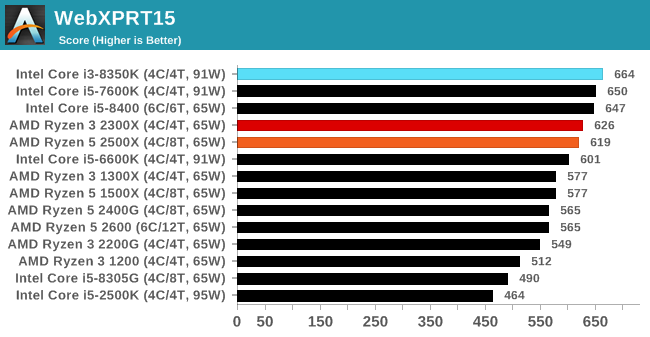
Speedometer 2: JavaScript Frameworks
Our newest web test is Speedometer 2, which is a accrued test over a series of javascript frameworks to do three simple things: built a list, enable each item in the list, and remove the list. All the frameworks implement the same visual cues, but obviously apply them from different coding angles.
Our test goes through the list of frameworks, and produces a final score indicative of ‘rpm’, one of the benchmarks internal metrics. We report this final score.
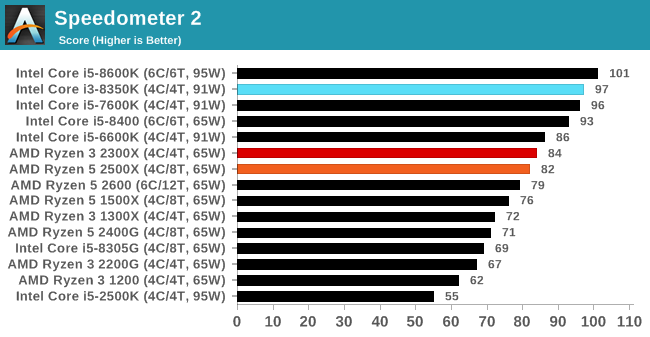
Google Octane 2.0: Core Web Compute
A popular web test for several years, but now no longer being updated, is Octane, developed by Google. Version 2.0 of the test performs the best part of two-dozen compute related tasks, such as regular expressions, cryptography, ray tracing, emulation, and Navier-Stokes physics calculations.
The test gives each sub-test a score and produces a geometric mean of the set as a final result. We run the full benchmark four times, and average the final results.
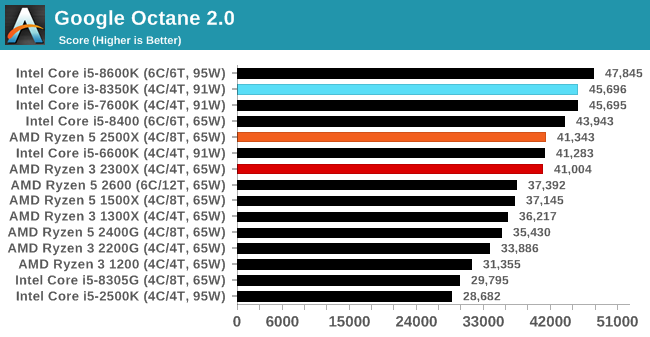
Mozilla Kraken 1.1: Core Web Compute
Even older than Octane is Kraken, this time developed by Mozilla. This is an older test that does similar computational mechanics, such as audio processing or image filtering. Kraken seems to produce a highly variable result depending on the browser version, as it is a test that is keenly optimized for.
The main benchmark runs through each of the sub-tests ten times and produces an average time to completion for each loop, given in milliseconds. We run the full benchmark four times and take an average of the time taken.
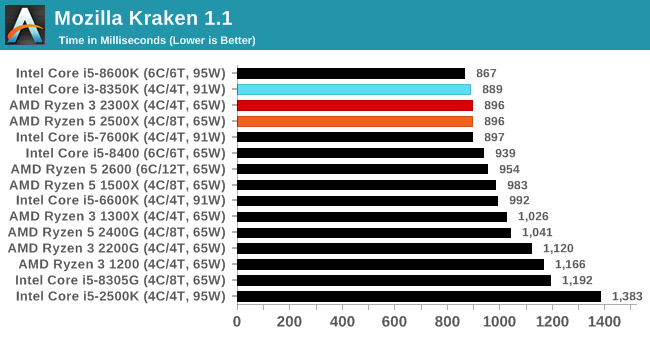
3DPM v1: Naïve Code Variant of 3DPM v2.1
The first legacy test in the suite is the first version of our 3DPM benchmark. This is the ultimate naïve version of the code, as if it was written by scientist with no knowledge of how computer hardware, compilers, or optimization works (which in fact, it was at the start). This represents a large body of scientific simulation out in the wild, where getting the answer is more important than it being fast (getting a result in 4 days is acceptable if it’s correct, rather than sending someone away for a year to learn to code and getting the result in 5 minutes).
In this version, the only real optimization was in the compiler flags (-O2, -fp:fast), compiling it in release mode, and enabling OpenMP in the main compute loops. The loops were not configured for function size, and one of the key slowdowns is false sharing in the cache. It also has long dependency chains based on the random number generation, which leads to relatively poor performance on specific compute microarchitectures.
3DPM v1 can be downloaded with our 3DPM v2 code here: 3DPMv2.1.rar (13.0 MB)
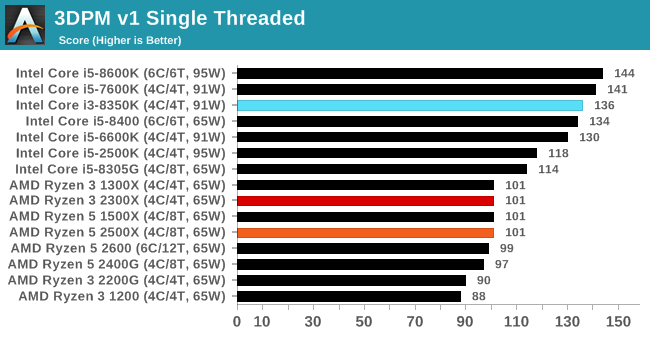
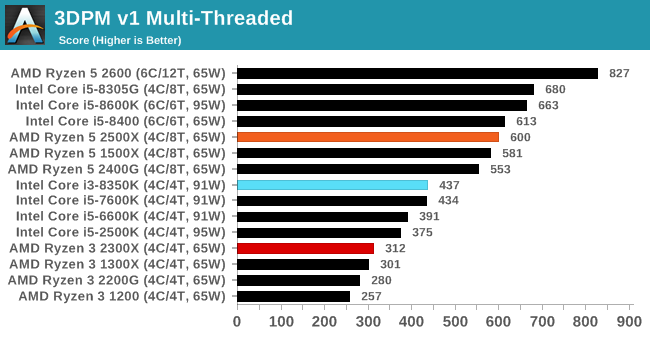
x264 HD 3.0: Older Transcode Test
This transcoding test is super old, and was used by Anand back in the day of Pentium 4 and Athlon II processors. Here a standardized 720p video is transcoded with a two-pass conversion, with the benchmark showing the frames-per-second of each pass. This benchmark is single-threaded, and between some micro-architectures we seem to actually hit an instructions-per-clock wall.
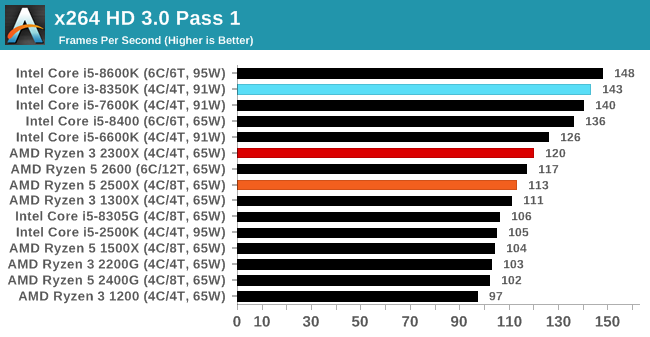
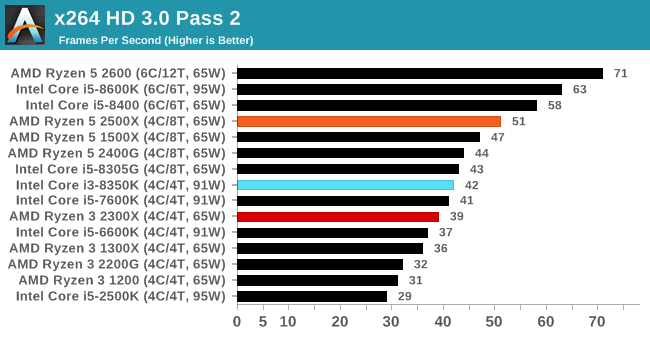










65 Comments
View All Comments
Smell This - Tuesday, February 12, 2019 - link
Thanks, Yall!"Where possible, we will extend out testing to include faster memory modules either at the same time as the review or a later date."
____ _____ _____ _____ _______
It would be sweet with some OC action, too.
Most impressive is the jump between the AMD Ryzen 2500X/1500X and Ryzen 3 2300X/1300X --- roughly 10% +/-. Good work, AMD.
I guess this is the difference between Zen and Zen+. With 7nm Zen ++ arriving soon, and Zen+++ next year, the CPU times they are a changin' ...
mr_yogi - Tuesday, February 12, 2019 - link
Love the inclusion of the i5 2500K, great job.Valantar - Tuesday, February 12, 2019 - link
These are both available from Norwegian retailers, though prices are ... not good. The 2500X costs as much as the 2600X, and the 2300X is barely cheaper than the 2600 (though admittedly the 2600 is _really_ cheap).urbanman2004 - Tuesday, February 12, 2019 - link
Reviewing CPU's that'll never reach the mainstream open market. Smart idea Anandtech 😉mikato - Thursday, April 4, 2019 - link
Are you saying it doesn't count if they are sold in prebuilt systems?tygrus - Tuesday, February 12, 2019 - link
AMD APUs (2400G & 2300G) try to keep atleast 50% of the power budget for GPU so the CPU load graph doesn't show the whole picture. It shows the power used for all chips for CPU load not CPU+GPU load. While having a mixture of CPU-only & CPU+GPU chips present means you want to focus on the CPU the reader needs to be reminded that the CPU+GPU load will be higher.I wish AMD had option for 95w TDP APU to compete with Intel models. With more CPU cores/headroom and 25% more GPU to use that 95w+ peak.
azrael- - Wednesday, February 13, 2019 - link
One reason to favor the 2300X and 2500X over the 'G' series CPUs is that Pinnacle Ridge supports ECC whereas Raven Ridge does not.Icehawk - Wednesday, February 13, 2019 - link
I'm begging here - can you please, please, please show us your config settings for the HEVC encoding? You get rates that are 6x+ faster than I can achieve - my O/C'd 8700k gets ~45fps with 1080 Fast 3500 settings using all else as default in Handbrake. I'd really love to hit the #s you get with just an i5. Help!Ian Cutress - Friday, February 15, 2019 - link
Check page 3?https://www.anandtech.com/show/13945/the-amd-ryzen...
xrror - Wednesday, February 13, 2019 - link
One additional savings for OEMs - they won't need to populate the motherboard components for integrated video on systems shipped with these.No need for displayport/HDMI/VGA connectors and associated filtering bits, so that saves a bit more on total BOM for the OEM.